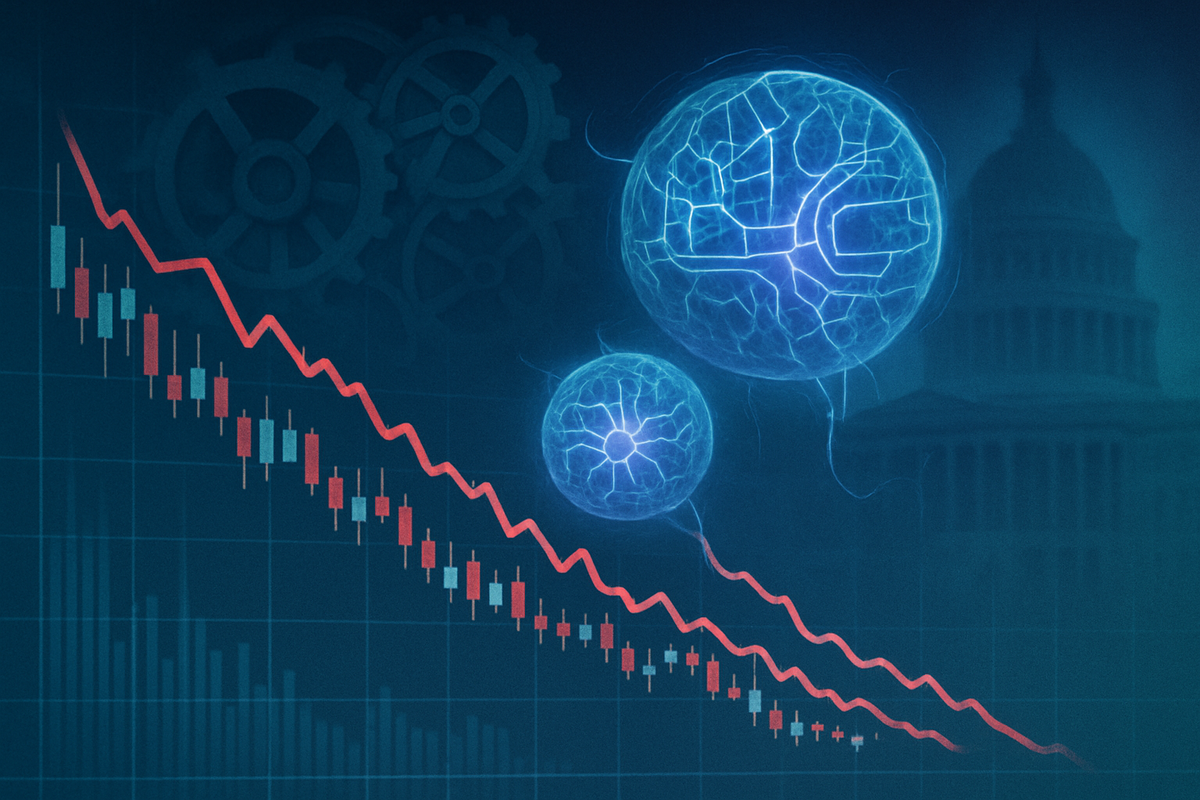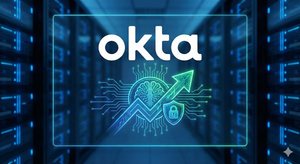S&P 500 Retreats from Record Highs Amid AI Bubble Fears and Government Gridlock

October 9, 2025 – The S&P 500 (SPX) experienced a notable pullback today, retreating from its recent record highs and signaling a potential shift in market sentiment. The benchmark index, which has enjoyed a period of robust gains, fell approximately 0.3% from its latest all-time high, marking only its second loss in the past ten days. This modest but significant decline has prompted investors to reassess market sustainability, with mounting concerns over an "AI bubble," the ongoing U.S. government shutdown, and evolving Federal Reserve policy expectations contributing to the unease.
This retreat is widely interpreted as a "heat check" for the market, suggesting a period of consolidation or a modest correction rather than an immediate selloff. However, the confluence of factors at play indicates a more cautious investment environment, shifting focus from relentless growth to underlying fundamentals and macroeconomic stability. The immediate implications include widespread profit-taking after an extended rally, particularly in the tech sector, and heightened scrutiny of valuations that many analysts now deem stretched.
Detailed Coverage: A Confluence of Factors Drives Market Pullback
The S&P 500's retreat on October 9, 2025, saw the index drop by 0.3%, trading around 6,720 to 6,735, after nearing what some analysts described as "historic bubble levels." This pullback was not an isolated event but rather the culmination of several significant market drivers and uncertainties. Beyond the S&P 500, the Nasdaq Composite (IXIC) also declined by approximately 0.1% to 0.3%, and the Dow Jones Industrial Average (DJIA) fell 0.4%, or 128 points, to 46,473.14.
A primary catalyst for the market's apprehension is the escalating concern about an "AI bubble." The enthusiasm surrounding artificial intelligence has largely fueled the market's multi-year bull run, with technology stocks now accounting for approximately 40% of the S&P 500. However, major institutions like the Bank of England and the International Monetary Fund (IMF) have issued stark warnings about "stretched valuations" in the AI sector, drawing parallels to the dot-com bubble of 2000. While companies like Nvidia (NASDAQ: NVDA) saw its stock hit a new all-time intraday high of $195.30 today following an analyst upgrade, other AI-related firms like Advanced Micro Devices (NASDAQ: AMD) experienced slight declines, and Oracle (NYSE: ORCL) faced a sharp decline due to lower-than-expected cloud division margins.
Adding to the market's trepidation is the ongoing U.S. government shutdown, which entered its ninth day on October 9. The failure of Congress to pass appropriations legislation has led to the furlough of approximately 900,000 federal employees and delayed the release of crucial economic data, including nonfarm payrolls and jobless claims. This information vacuum is fostering uncertainty and encouraging a cautious investment environment, making it harder for investors and the Federal Reserve to accurately assess economic conditions.
Furthermore, speculation surrounding the Federal Reserve's monetary policy continues to influence market movements. While the Fed implemented a quarter-point rate cut in September 2025, bringing the federal funds rate to 4.00%-4.25%, mixed signals from Fed officials regarding the pace and extent of future reductions are causing traders to reassess. Concerns about a "higher for longer" interest rate environment could negatively impact highly valued growth stocks. Rising bond yields, with the 10-year Treasury yield climbing to 4.15% today, also contributed to the market's decline, sparking "long liquidation pressures" in sectors like chipmakers.
Beyond equity markets, other reactions included gold prices falling below $4,000 per ounce, silver surging past $50 for the first time in decades, and oil prices sinking as Middle East tensions cooled. The U.S. dollar climbed toward a 10-week high, and short-bias Exchange-Traded Funds (ETFs) saw significant inflows, signaling a palpable investor unease and positioning for a potential pullback.
Companies Navigating the Shifting Sands: Winners and Losers
The S&P 500's retreat on October 9, 2025, has created a clear delineation between potential winners and losers in the market, heavily influenced by the prevailing concerns over AI valuations, the government shutdown, and interest rate expectations.
Potential Losers and Vulnerable Companies/Sectors:
Highly valued technology and AI growth stocks are at the forefront of vulnerability due to stretched valuations and the looming "AI bubble" concerns. Companies with high price-to-earnings (P/E) ratios and those whose valuations are primarily based on future growth rather than current profitability are particularly exposed. This includes smaller, pure-play AI firms like Aehr Test Systems (NASDAQ: AEHR), which experienced a significant pullback, and companies like Palantir Technologies (NYSE: PLTR) and Arm Holdings (NASDAQ: ARM), facing scrutiny for "wildly overvalued" metrics. Oracle (NYSE: ORCL) also saw a sharp decline, reflecting increased investor scrutiny on profitability within the AI cloud space. Chipmakers in general faced pressure due to higher bond yields and profit-taking. Interest-rate sensitive growth stocks and highly leveraged companies will also face headwinds from cooling rate cut expectations and potentially higher borrowing costs. Consumer discretionary, hospitality, and certain manufacturing sectors could also suffer from a prolonged government shutdown dampening consumer confidence and spending. Boeing (NYSE: BA) continues to face stock pressure due to aerospace industry challenges, and Fair Isaac (NYSE: FICO) tumbled after rival Equifax (NYSE: EFX) announced plans for reduced-price credit scores.
Potential Winners and Resilient Companies/Sectors:
Conversely, sectors and companies with strong fundamentals, defensive characteristics, or those providing essential AI infrastructure are showing resilience. The healthcare sector (XLV) has demonstrated remarkable stability, acting as a defensive play due to inelastic demand for its services. The energy sector (XLE) is also holding up well, supported by stable oil prices, and the financial sector (XLF) is benefiting from the prospect of favorable interest rate changes. Companies providing foundational infrastructure for AI, rather than purely speculative AI software, continue to see strong demand. Nvidia (NASDAQ: NVDA), despite broader market pullbacks, hit a new all-time intraday high, underscoring its leadership in AI chips. Dell Technologies (NYSE: DELL) surged due to robust demand for AI infrastructure. Taiwan Semiconductor Manufacturing (NYSE: TSM) reported strong revenues, indicating sustained chip demand. Companies like Vertiv Holdings Co (NYSE: VRT) and Eaton Corporation plc (NYSE: ETN) (power and cooling for data centers), and Equinix, Inc. (NASDAQ: EQIX) (colocation data centers) are expected to see long-term demand. Businesses with strong cash flow, less reliance on debt, and diverse revenue streams are better positioned to navigate this environment. Consumer staples, exemplified by PepsiCo (NASDAQ: PEP) reporting better-than-expected Q3 results, offer stability. Costco (NASDAQ: COST) saw gains from consistent growth, and Delta Air Lines (NYSE: DAL) rose after raising its full-year adjusted EPS forecast, benefiting from improving travel demand.
Wider Significance: A Market at a Crossroads
The S&P 500's retreat on October 9, 2025, is more than just a daily fluctuation; it signals a critical juncture for the financial markets, intertwining with broader industry trends, potential ripple effects, and significant policy implications. This event underscores a growing market recalibration, driven by an overvalued AI sector and exacerbated by governmental and monetary policy uncertainties.
At the heart of the wider significance is the ongoing debate about market concentration and the "AI euphoria." With technology and AI-related firms comprising a historically high share of the S&P 500 (around 35-40%), the market's performance is heavily reliant on a few dominant players. This concentration introduces significant risk; a downturn in these bellwether stocks can magnify losses across the broader market. Warnings from central banks and financial institutions about an "AI bubble" are not merely speculative; they reflect concerns that optimistic expectations for AI's transformative impact may not be met, or that technological progress could be slower than anticipated, leading to a "sharp market correction" of 10-20% or more. This could force a strategic pivot for companies that have relied on easy capital and speculative valuations, compelling them to focus on profitability and sustainable business models.
The ripple effects extend across entire ecosystems. A correction in mega-cap technology stocks would impact their vast networks of suppliers, partners, and customers, particularly in the semiconductor industry, where enormous investments in manufacturing capacity could prove excessive if demand wanes. Private markets, including venture capital and private equity, which have also seen stretched valuations, could experience a repricing, making fundraising more challenging for startups. Conversely, stronger companies with robust balance sheets might find strategic opportunities to acquire undervalued assets or distressed competitors.
Regulatory and policy implications are amplified by the confluence of events. The U.S. government shutdown, by suspending key economic data releases, forces the Federal Reserve to operate with limited visibility, potentially complicating its monetary policy decisions. Historically, the Fed often intervenes to ease policy in response to market downturns—a phenomenon sometimes referred to as the "Fed put." However, the current environment presents a unique challenge of navigating persistent inflation while avoiding a significant economic contraction. A prolonged shutdown could further hinder the Fed's ability to accurately assess economic conditions for future rate decisions. Moreover, a significant market downturn could prompt increased scrutiny of speculative activities, particularly in the AI sector, potentially leading to calls for tighter regulations on financial institutions and "circular deals" that fuel AI valuations.
Historical precedents offer valuable context. The dot-com bubble of 1999-2000, characterized by speculative fervor and overvaluation of unproven technologies, serves as a stark warning. The NASDAQ Composite fell 78% after the bubble burst, leading to significant losses. While today's AI-driven market has some fundamental differences, the astronomical valuations and investment frenzy bear striking resemblances. Other historical corrections, often linked to Federal Reserve tightening cycles or geopolitical shocks, demonstrate that market downturns are a normal part of economic cycles, with the S&P 500 experiencing a greater than 5% drawdown almost annually. These comparisons highlight the importance of understanding underlying economic health and avoiding excessive speculation.
What Comes Next: Navigating Uncertainty and Opportunity
The S&P 500's retreat on October 9, 2025, ushers in a period of heightened uncertainty, but also potential strategic opportunities for discerning investors and adaptable companies. The immediate future suggests continued volatility, while the long-term outlook will hinge on how key economic and policy factors unfold.
In the short-term, the market is likely to remain highly sensitive to incoming economic data, geopolitical developments, and the upcoming third-quarter corporate earnings reports. Disappointing results from major tech companies, unexpected inflation spikes, or a prolonged government shutdown could trigger further sharp sell-offs. We may see continued sector rotation, with investors shifting out of potentially overvalued growth sectors like technology and AI into more defensive sectors such as consumer staples, healthcare, and utilities, which tend to offer stability during downturns. The "buy the dip" mentality, prevalent during the recent bull run, might be tested, potentially giving way to a more cautious consolidation phase. Increased hedging activity, as evidenced by recent inflows into short-bias ETFs, suggests investors are already positioning for turbulence.
Looking at the long-term possibilities, a "soft landing" scenario remains plausible if the retreat is indeed a temporary correction, and underlying economic fundamentals (like employment and corporate earnings) remain robust. In this scenario, the market could stabilize and resume an upward trend, particularly if anticipated interest rate cuts materialize. However, a "hard landing" involving a prolonged bear market or a significant economic recession cannot be ruled out, especially if the "AI bubble" bursts or consumer credit stress escalates. The Federal Reserve's ability to manage persistent inflation while avoiding an economic contraction will be crucial. A significant market correction could also force a re-evaluation of company valuations, particularly for those with exorbitant valuations based more on future growth expectations than current profitability.
Strategic pivots and adaptations will be critical for companies. This includes focusing on cost restructuring, enhancing financial discipline, and prioritizing core customers. Companies will need to invest in innovation and technology adoption to improve operational efficiency and potentially explore strategic mergers and acquisitions to acquire undervalued assets. For investors, the advice remains consistent: avoid impulsive reactions, stay invested for the long term, and maintain a diversified portfolio. Rebalancing regularly helps align the portfolio with the intended risk profile. Focusing on high-quality, defensive stocks and looking for strategic buying opportunities during downturns (e.g., dollar-cost averaging) can prove beneficial.
Emerging markets face increased challenges, as they are often more sensitive to global capital flows and risk sentiment. A U.S.-led market correction could lead to capital outflows and currency depreciation in these economies, impacting trade and growth. However, some emerging markets with strong fundamentals and pre-crisis reserve holdings might mitigate the initial impact, potentially offering opportunities for diversification for savvy investors.
Ultimately, the market faces several potential scenarios: a continued "soft landing" with resumed growth, a "hard landing" leading to a severe recession, or a "grinding bear market" characterized by prolonged volatility. The most significant concern remains the potential burst of the AI bubble, which could trigger a substantial decline in the S&P 500 due to negative earnings revisions, disproportionately affecting the tech sector. While market downturns are unsettling, history shows they are a normal part of the economic cycle and often present opportunities for well-informed and disciplined investors.
Wrap-up: Navigating a Period of Reassessment
The S&P 500's retreat on October 9, 2025, marks a significant moment of reassessment for the financial markets, signaling a potential shift from an era of unbridled optimism to one of heightened caution. The key takeaways from this event are multi-faceted: the market's vulnerability to "AI bubble" concerns, the destabilizing effect of political gridlock (the government shutdown), and the ongoing influence of Federal Reserve policy. This pullback, while modest in scale, has exposed underlying anxieties about stretched valuations, particularly in the technology sector, and a growing desire among investors for more sustainable, fundamentally driven growth.
Moving forward, the market is likely to experience increased volatility as it digests new economic data, corporate earnings, and any resolutions (or lack thereof) regarding the government shutdown. The "heat check" sentiment suggests that a period of consolidation or further modest correction is more probable than an immediate return to previous highs. The market's resilience will be tested, and its ability to absorb these pressures without spiraling into a deeper downturn will depend on the interplay of corporate profitability, consumer confidence, and decisive policy actions.
The lasting impact of this retreat could be a recalibration of investor expectations, fostering a more discerning approach to valuations, especially in high-growth sectors. It might also lead to a renewed appreciation for defensive sectors and companies with strong balance sheets and consistent cash flows. For the broader economy, a prolonged period of market uncertainty could dampen consumer and business spending, potentially affecting GDP growth.
What investors should watch for in the coming months:
- Resolution of the Government Shutdown: A swift and amicable resolution would alleviate a major source of uncertainty, while a prolonged impasse could further erode confidence and delay economic data releases.
- Federal Reserve Communications: Investors should closely monitor any statements or actions from the Federal Reserve regarding interest rates. Any deviation from expected rate cut paths could significantly impact market sentiment.
- Third-Quarter Earnings Reports: The upcoming earnings season will provide crucial insights into corporate health and profitability, particularly for mega-cap technology and AI-related companies. Disappointing results could exacerbate market pressures.
- Inflation Data and Economic Indicators: Key economic data, once available, will offer a clearer picture of inflationary pressures, employment trends, and overall economic growth, influencing both Fed policy and market direction.
- AI Sector Developments: Continue to monitor the performance and valuation metrics of AI-focused companies. Any signs of a true "AI bubble" bursting would have significant ramifications across the market.
- Market Breadth: Observe whether the rally, if it resumes, is broad-based or continues to be concentrated in a few large-cap stocks. A broader participation would indicate a healthier market.
In conclusion, the S&P 500's retreat is a timely reminder that market cycles include periods of reassessment and consolidation. While unsettling, such moments often provide opportunities for long-term investors to re-evaluate their portfolios and position themselves for future growth by focusing on quality and diversification amidst evolving market dynamics.
This content is intended for informational purposes only and is not financial advice.
More News
View More




Recent Quotes
View More
Quotes delayed at least 20 minutes.
By accessing this page, you agree to the Privacy Policy and Terms Of Service.